Acer Switch 3 review: Cheap, capable, underwhelming
A budget 2-in-1 experience that does little to excite
Acer's budget detachable offers an entry-level route into the 2-in-1 market, with a capable performance and fairly decent battery life. Unfortunately, with no one stand-out feature and a barebones feature set, its lower price is the only thing going for it.
-
+
Cheap for a 2-in-1; Fairly decent port selection; Great keyboard for the price
-
-
Barebones in terms of features
Acer's detachable laptops have traditionally always positioned themselves as cheaper alternatives to the Surface Pro range, while still providing a similar tablet/laptop hybrid experience. In our review of the Switch 5 we highlighted a number of quibbles, concluding at the time that it was worth paying that little extra to get the best-in-class Surface Pro.
Much like its more expensive sibling, the Switch 3 is aimed at those who need the flexibility of a tablet mixed with the functionality of a laptop, only this time a few of the more fancy features, such as liquid cooling, have been stripped out in favour of a more attractive price tag. Provided the Switch 3 is able to replicate some of the Switch 5's magic, it has the potential to be a serious contender for the mid-range crown.
Acer Switch 3: Design & connectivity
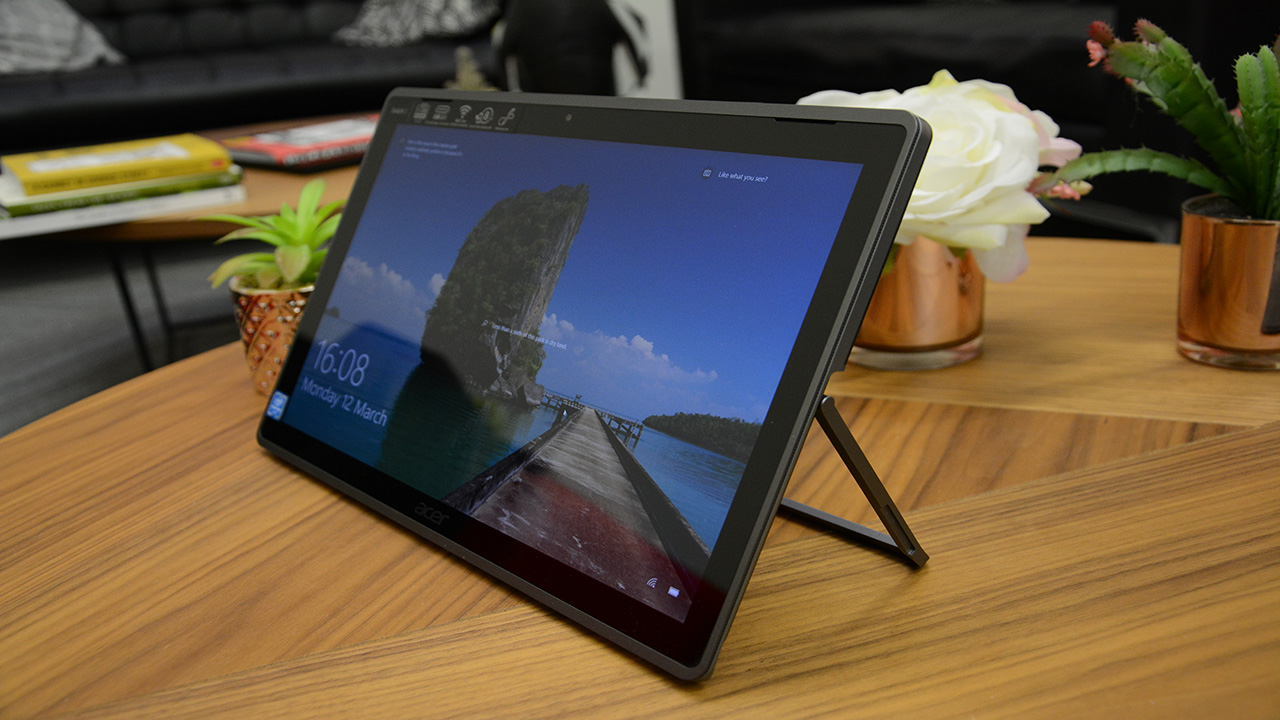
The first thing to mention is that the Switch 3 is almost identical to the Switch 5. It uses the same hinge design that's proving incredibly popular among 2-in-1s, only with a metal bar for a kickstand instead of a panel. True to the Switch range's reputation, it's an incredibly well-built machine and feels reassuringly solid in the hands, and uses that serrated edge that Acer seems to favour.
However, it's notably heavier and thicker than both its sibling and many other detachable 2-in-1s on the market, including the far cheaper Asus Transformer Mini. With its keyboard attached it feels almost a little too chunky at 16.2mm thick, compared to around 13mm on the Surface Pro. It's that extra lick of style and luxury that you'd find on expensive devices that is missing here, but given how svelte 2-in-1s are generally, it's far from a deal breaker, and it's still thin and light enough to slide into a bag easily.
One problem it can't shrug off is that the use of the same metal bar kickstand found on Switch 5 brings with it all the same problems. The bar itself has rough edges to it, which doesn't feel great in the hands, while the hinge mechanism is stiffy and clunky, and has a snapback function that will angle the tablet back to a fixed position if there isn't enough weight pressing down on it. If you're using it on your lap, you'll find yourself adjusting the stand to fit your needs, only for it to snap back when you move your legs. It does angle back to 165 degrees, however, so there's plenty of options when it comes to viewing angles.
The great thing is that a lower price hasn't affected the fairly decent range of port options that graced the Switch 5. You still get a USB Type C slot, one USB 3.0, and a microSD port, a selection that puts even the mighty Surface Pro to shame. It's also worth noting that it comes with a dedicated power port, meaning the USB C port remains free while you're charging.
Acer Switch 3: Keyboard, trackpad & stylus
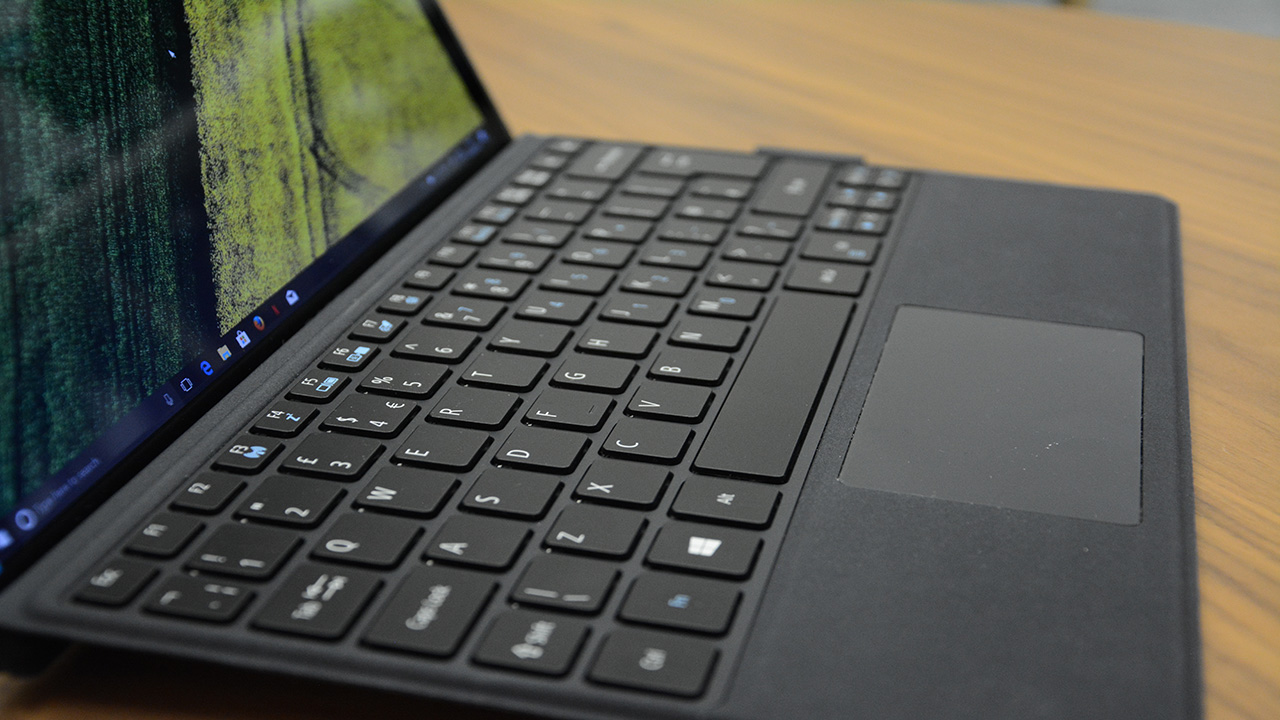
While there are a host of higher-end Surface Pro rivals that offer both a keyboard and stylus as standard (mainly as a means of offering a slightly better value proposition) it's great to see a cheaper device following this trend. What's more, it's the same great keyboard and stylus that comes with the Switch 5, offering a similar, albeit less refined experience to the Surface Pro.
The keyboard uses the magnetic-style connector favoured by the Surface Pro range that lets you easily pull the board away from the tablet, and allows you to place the board back on in reverse so that you don't have to leave it at your desk. Unfortunately, our model's keyboard had a nasty habit of staying switched on when reversed, which meant you would inadvertently press keys if you tried to use it as a tablet.
The keyboard also uses the Surface Pro's magnetic strip solution that allows the keyboard to stick to the screen and provide elevation while typing. It's also incredibly well built considering the price of the tablet. In particular, even though it's elevated, there's none of the bounce you get while typing on thinner boards. As is the case with the Switch 5, the keys are nicely spaced and allow for accurate touch typing, with enough travel time to give just enough feedback with each keystroke.
Unfortunately, the use of the same board means the fairly underwhelming touchpad also makes an appearance. That's not to say it's terrible, as it works perfectly fine, but it's coated with a plastic that feels cheap compared to glass or metal and can cause your fingers to occasionally stick as you swipe.
Acer, like many other 2-in-1 manufacturers, continues to make a fundamental mistake when it comes to the stylus placement. Instead of attaching to the tablet's screen with a magnet like the Surface Pro, it uses a loop fitted to the keyboard. The problem here is that while the magnetic strip has its faults, it does allow you to carry the stylus with you when you want to use the Surface purely as a tablet.
Ultimately, the stylus is going to be something that most users will leave in the box, but it works well enough for those who need to do some writing or designing - just don't expect the same quality you'd find on an Apple or Microsoft device, or the same range of features.
Acer Switch 3: Display
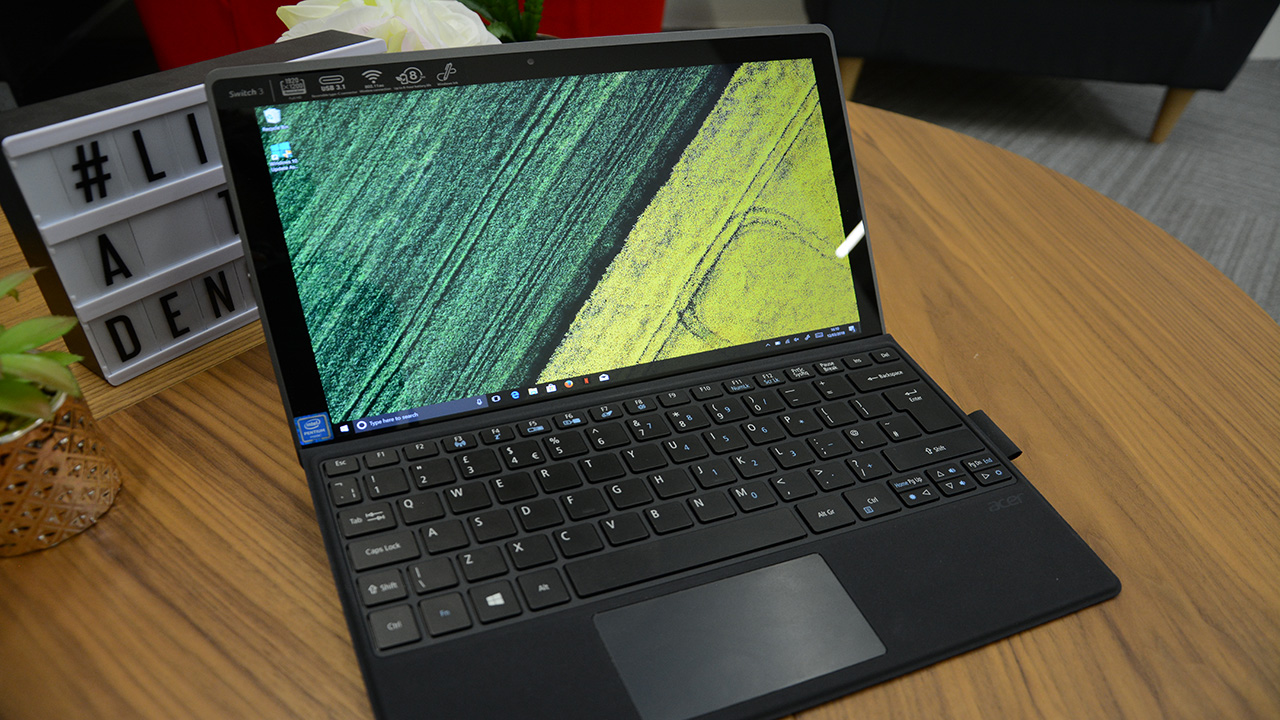
It's great to see a full HD screen on the Switch 3, as it may have been tempting to drop that down to 720p given the price. What's more, it also stands up very well against its more expensive sibling.
Colour replication is great at 88% of the gamut, while a superb contrast ratio of 1096:1 allows for deep blacks and bright whites. That's compared to just 78% gamut coverage and 845:1 ratio on the Switch 5 - pretty good for a sub-500 convertible. Max brightness is also spot on at 369cd/m2; once again, better than its sibling.
Overall, you're getting a very capable display that's going to perform very well in a variety of lighting environments, which is particularly reassuring on a device that you're almost certainly going to want to keep with you as you move about an office.
Acer Switch 3: Hardware & performance
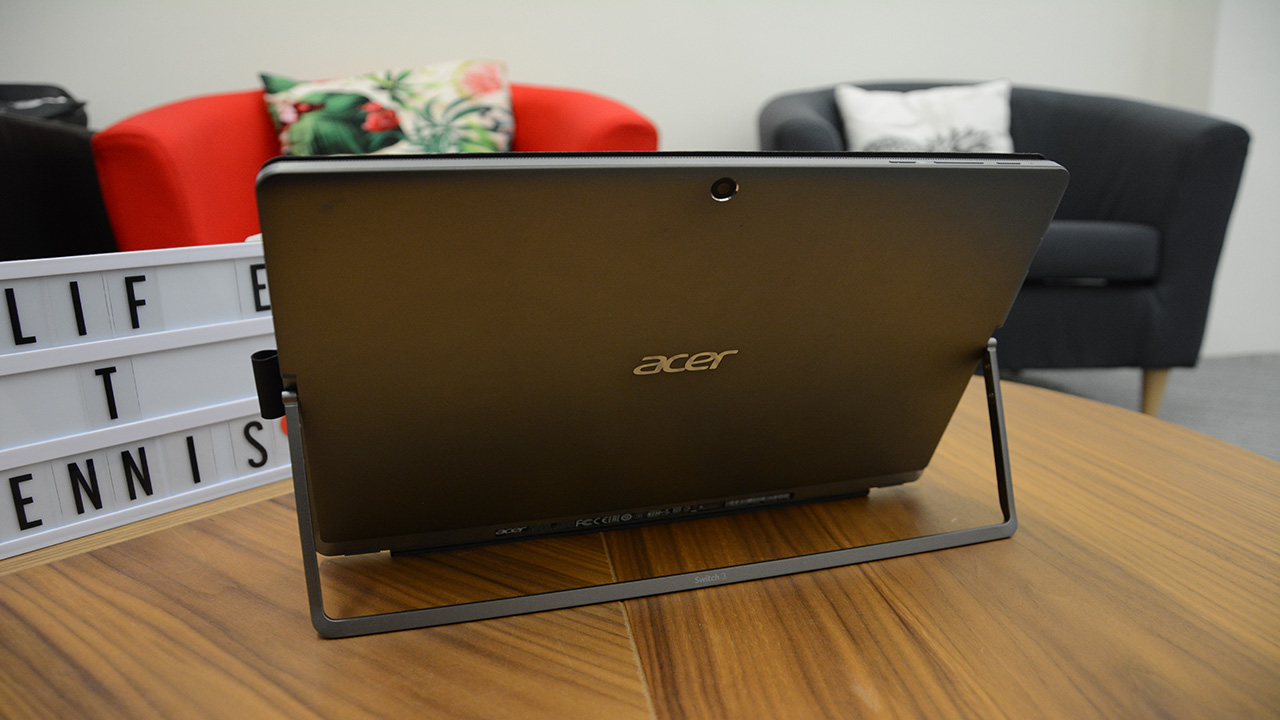
The Switch 3 is fitted with an Intel Pentium N4200 Quad-Core 1.1GHz processor, 4GB of RAM, and 64GB of eMMC storage - a fairly modest spec to say the least. However, the use of a Pentium gives it a slight performance edge over rival devices using Atom processors, such as the Transformer Mini. While it's far from a powerhouse, the Switch 3 performed relatively well during our benchmark testing with an overall score of 23, and while that's far from the high 40s of the Switch 5, it's important to remember that this is, for all intents and purposes, a budget device.
The main thing is that the Switch 3 never felt like it was holding us back. It's nippy enough for everyday workloads, multitasking, and multi-tab browsing, and you can't really ask for more in a package like this.
It also managed to last just under 7 hours in our battery tests, which is about what you'd expect from a 2-in-1 device at this price range. A slight power reduction from the Switch 5 has, thankfully, translated to a little extra juice between charges, but it's still not quite long enough to comfortably support a full day of office work.
Unfortunately, the Switch 3 is also fairly light on features. Most notably, the liquid cooling system that made the Switch 5 stand out among rivals has been stripped away, likely in an effort to bring the price down. In fact, to compensate for an underwhelming list of tools, Acer has attempted to hail the Switch 3's compatibility with Microsoft's note-taking software, Windows Ink, as its headline feature, just above the inclusion of a USB Type C port - they're both nice to see, but they're hardly game changers.
Acer Switch 3: Verdict
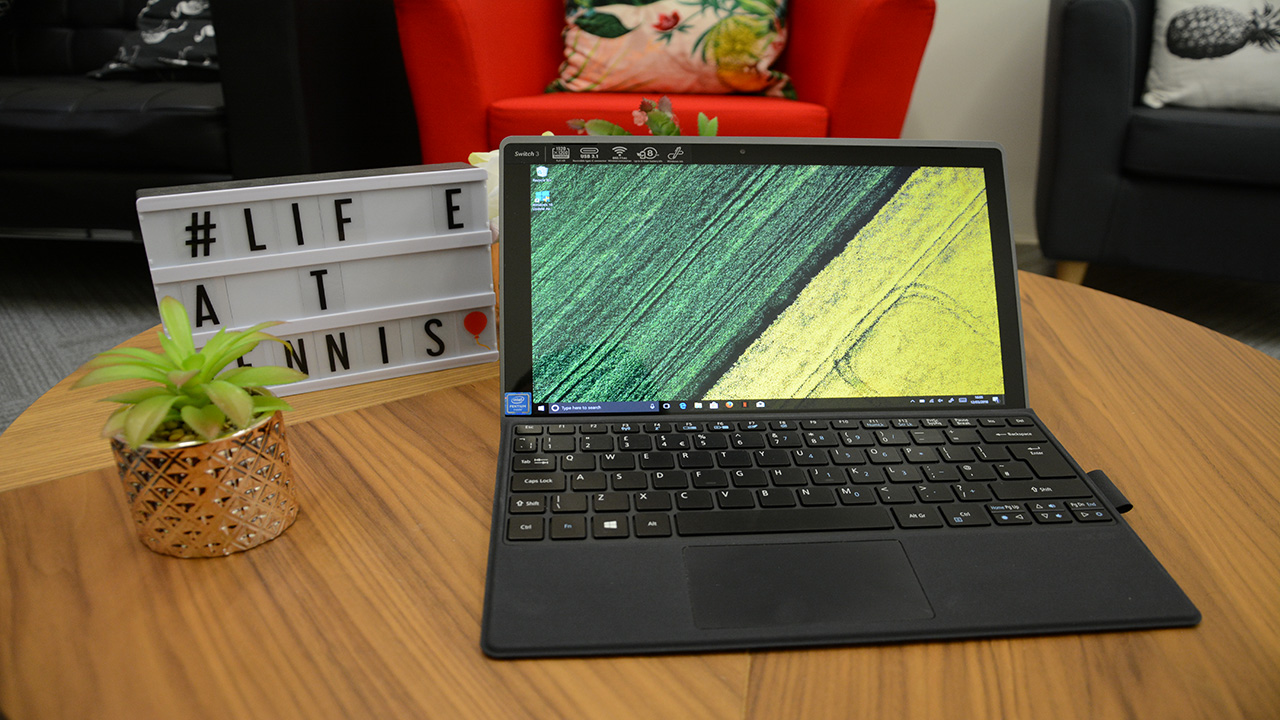
The Switch 3 has been a difficult device to review. It offers great value for money for those looking for a capable 2-in-1 experience, but who've been put off by the exorbitant costs normally associated with the market. It's a solid, well-built machine, with a decent battery life and a good 1080p screen, and performs perfectly well as a business machine.
Yet that's all within the context of its price. It's a fairly underwhelming device that does little to make itself stand out on the market. There's no one feature that's particularly impressive, and that presents a problem for the buyer. If you're in need of the flexibility that a 2-in-1 device offers, but want to spend as little as possible, this is the device for you. Yet, we can't help but feel you'd be better off putting your money into an ultrabook, perhaps even Acer's Swift range.
If you want something cheap and functional, it's a good option - just don't expect it to wow you.
Verdict
Acer's budget detachable offers an entry-level route into the 2-in-1 market, with a capable performance and fairly decent battery life. Unfortunately, with no one stand-out feature and a barebones feature set, its lower price is the only thing going for it.
| CPU | Intel Pentium N4200 quad-core 1.1GHz |
| RAM | 4GB |
| GPU | Intel HD Graphics 505 |
| Screen | 12.2in, 1,920 x 1,200 |
| Dimensions | 295 x 202 x 10mm, (16mm w/ keyboard), 0.9kg (1.25kg) |
| Ports | 1 x USB 3.0, 1 x USB Type C, headphone, microSD |
| Storage | 64GB flash memory |
Get the ITPro daily newsletter
Sign up today and you will receive a free copy of our Future Focus 2025 report - the leading guidance on AI, cybersecurity and other IT challenges as per 700+ senior executives
Dale Walker is a contributor specializing in cybersecurity, data protection, and IT regulations. He was the former managing editor at ITPro, as well as its sibling sites CloudPro and ChannelPro. He spent a number of years reporting for ITPro from numerous domestic and international events, including IBM, Red Hat, Google, and has been a regular reporter for Microsoft's various yearly showcases, including Ignite.
-
 Westcon-Comstor and Vectra AI launch brace of new channel initiatives
Westcon-Comstor and Vectra AI launch brace of new channel initiativesNews Westcon-Comstor and Vectra AI have announced the launch of two new channel growth initiatives focused on the managed security service provider (MSSP) space and AWS Marketplace.
By Daniel Todd Published
-
 Third time lucky? Microsoft finally begins roll-out of controversial Recall feature
Third time lucky? Microsoft finally begins roll-out of controversial Recall featureNews The Windows Recall feature has been plagued by setbacks and backlash from security professionals
By Emma Woollacott Published
-
 The UK government wants quantum technology out of the lab and in the hands of enterprises
The UK government wants quantum technology out of the lab and in the hands of enterprisesNews The UK government has unveiled plans to invest £121 million in quantum computing projects in an effort to drive real-world applications and adoption rates.
By Emma Woollacott Published